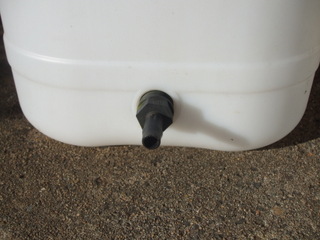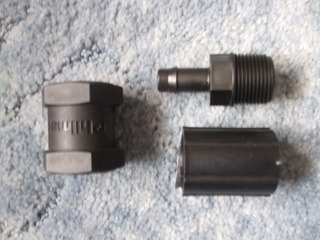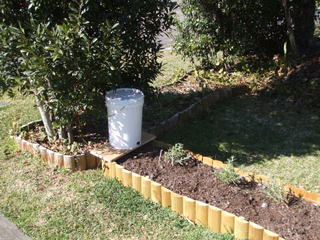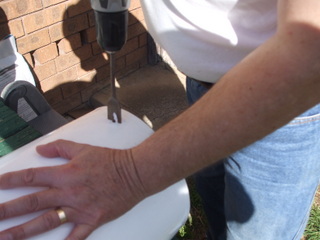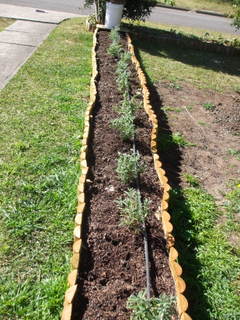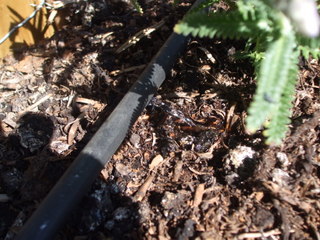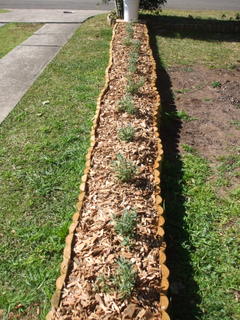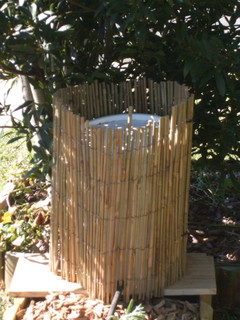Here in Sydney last summer was cool and wet so I didn’t need to do much with irrigation for the fruit, veggies and herbs, but they tell us that this summer is going to be a long and hot one so I’ll have to get my act together and make sure we can deliver the water to where it is needed. I needed to put together something for the lavender hedge to help it get established, but the system should work equally well in the veggie patches out the back as well.
The system that I put together consists of a reservoir, delivery tube and a connecter joining the two –
The Reservoir – I used a recycled 20 litre container with lid but I could just as easily have used a 20litre recycled plastic cube or even a 200 litre drum or old wheelie bin. Whatever you use it should have a cover on it to stop small animals being drowned and keep out windblown rubbish that may block up the holes in the delivery pipe.
The Connector – this is one of the most wonderful little plastic doohickies known to man – a ¾ inch BSP to 13mm barb poly fitting. It can be screwed directly into the bung on the bottom of a plastic cube but will need to be correctly fitted into any solid walled container that you want to use. They do come in different sizes so you can use larger delivery hose if you have access to it, but the 13mm sizing works well with this set up. (The connectors are available from specialist irrigation suppliers or the irrigation section of large hardware stores.)
The Delivery Hose – I used 13mm black plastic irrigation pipe because that is what I had! There has been a roll of it kicking around the shed for years so it seemed like a good choice, but I could have used recycled standard 12mm garden hose as well. Even if the hose was too weathered to hold pressure it would be OK for this project because the water was delivered by gravity and so pressure is minimal.
There are a number of advantages to this type of irrigation –
- Low cost/no cost to set up
- Can be filled with water from any source eg water saved from the shower while waiting for the water to run hot or from a rainwater tank
- Efficiency, there are little or no losses to evaporation or runoff, especially if the water is applied under a layer of mulch
- Water application is also very efficient in that each plant can be separately targeted.
The down sides are that this is still a fairly manual process, needing to be topped up by hand and the delivery pipes will need to be moved when cultivating or replanting the bed.
Putting the System Together
1. Before I started on the irrigation system I needed to work out which end of the bed the reservoir should go, the bed appeared to run downhill from the Bay tree but I used a spirit level to confirm this was the case. Seeing as water runs down hill, under the bay tree is where I put the reservoir,to give it a bit more height and to make sure it had a steady base I put a bit of scrap timber across the end of the bed surround and then sat the reservoir on it.
2. I used a recycled 20 litre bucket as my reservoir so I drilled a hole in the side, towards the bottom using a 25mm spade bit in my electric drill. If I was using a 20 litre cube, there is already a hole in the bottom for the fitting to screw into so this step would be unnecessary.
3. I screwed the fitting into the hole and then screwed a ¾ inch BSP socket on the fitting, inside the bucket. I Screwed it down tight and got a reasonable seal but the system is outside and not under pressure so the odd drop of leakage should not be a problem, but if it is run a bead of silicon around the fitting on the outside of the bucket will fix it. (always remember – silicon is my friend)
4. I ran the delivery hose, in this case 13mm irrigation pipe, along the bed and cut it to length and put a plug in the end. If I didn’t have an end plug hanging around I would have bent the free end back on itself and secured it with a clip or bit of wire or something.
5. I then secured the free end to the ground with a wire loop to hold it in place until I put the mulch on. The mulch would hold it in place, stop it from getting too hot and lengthen the life pipe by keeping it away from UV radiation from the sun.
6. Using my battery drill I then drilled a 1/8 inch hole just uphill of each plant that would need to be watered and that seemed to work pretty well, with each plant getting a reasonable flow rate when I checked it out.
7. Once I was happy that the plants would be getting enough water I put the wood chip mulch on, to me it looked pretty good but my lovely partner in the sustainable life was not happy with the look of the white plastic bucket, so there was one more job.
8. We discussed several ways to disguise the bucket but settled on a screen made of bamboo which certainly camouflages it well.
This system is a very simple one but there is a huge variety of fittings available that also make it very flexible. Due to the irrigation system being powered by gravity it would make sense not to put too many bends and kinks in it though that will slow the water down before it gets to the end of your delivery pipe. If you do start having problems you could raise the reservoir up on a wooden framework to provide more “head” or pressure to get the water where it needs to go. You could also consider a bigger diameter main delivery hose with smaller ones off to the sides to deliver water directly to the plants.



